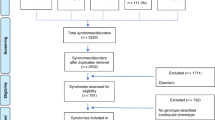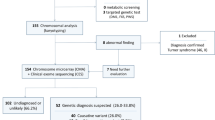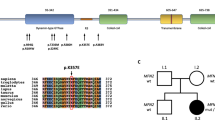Abstract
Approximately 3% of the live-born infants have major dysmorphic features, and about two-thirds of which are observed in the maxillofacial region; however, in many cases, the etiology of the dysmorphic features remains uncertain. Recently, the genome-wide screening of large patient cohorts with congenital disorders has made it possible to discover genomic aberrations corresponding to the pathogenesis. In our analyses of more than 536 cases of clinically undiagnosed multiple congenital anomalies and mental retardation (MR) by microarray-based comparative genomic hybridization, we detected two non-consanguineous unrelated patients with microdeletions at 10p11.23-p12.1, which overlapped for 957 kb, including four protein-coding genes: ARMC4, MPP7, WAC and BAMBI. As the two patients had similar phenotypes; for example, MR and multiple maxillofacial abnormalities including midface retrusion, wide mouth and large tongue, we assessed the phenotypes in detail to define the common features, using quantitative evaluations of the maxillofacial dysmorphism. The concordance of the genetic and phenotypic alterations is a good evidence of a new syndrome. Although an interstitial deletion of 10p is rare, the current study is the first trial to examine precisely the craniofacial characteristics of patients with a heterozygous deletion at 10p11.23-p12.1, and presents good evidence to diagnose potential patients with the same genetic cause.
Similar content being viewed by others
Log in or create a free account to read this content
Gain free access to this article, as well as selected content from this journal and more on nature.com
or
References
Centers for Disease Control and Prevention (CDC). Surveillance Summaries temporal Trends in the Incidence of Birth Defects – United States. Morb. Mortal. Wkly Rep. 46, 1171–1176 (1997).
Hunter, A.G. Outcome of the routine assessment of patients with mental retardation in a genetics clinic. Am. J. Med. Genet. 90, 60–68 (2000).
Lary, J. M. & Paulozzi, L. J. Sex differences in the prevalence of human birth defects: a population-based study. Teratology 64, 237–251 (2001).
Lisi, A., Botto, L.D., Rittler, M., Castilla, E., Bianca, S., Bianchi, F. et al. Sex and congenital malformations: an international perspective. Am. J. Med. Genet. A 134, 49–57 (2005).
Miller, D.T., Adam, M.P., Aradhya, S., Biesecker, L.G., Brothman, A.R., Carter, N.P. et al. Consensus statement: chromosomal microarray is a first-tier clinical diagnostic test for individuals with developmental disabilities or congenital anomalies. Am. J. Hum. Genet. 86, 749–764 (2010).
Hayashi, S., Imoto, I., Aizu, Y., Okamoto, N., Mizuno, S., Kurosawa, K. et al. Clinical application of array-based comparative genomic hybridization by two-stage screening for 536 patients with mental retardation and multiple congenital anomalies. J. Hum. Genet. 56, 110–124 (2011).
Shahdadpuri, R., de Vries, B., Pfundt, R., de Leeuw, N. & Reardon, W. Pseudoarthrosis of the clavicle and copper beaten skull associated with chromosome 10p11.21p12.1 microdeletion. Am. J. Med. Genet. A 146, 233–237 (2008).
Wentzel, C., Rajcan-Separovic, E., Ruivenkamp, C. A., Chantot-Bastaraud, S., Metay, C., Andrieux, J. et al. Genomic and clinical characteristics of six patients with partially overlapping interstitial deletions at 10p12p11. Eur. J. Hum. Genet. 19, 959–964 (2011).
Inazawa, J., Inoue, J. & Imoto, I. Comparative genomic hybridization (CGH)-arrays pave the way for identification of novel cancer-related genes. Cancer. Sci. 95, 559–563 (2004).
Coben, S. E. The integration of facial skeletal variants. Am. J. Orthod. 41, 407–434 (1955).
Iizuka, T. Roentgencephalometric analysis of craniofacial growth in Japanese children. J. Stomatol. Soc. Jpn 25, 18–30 (1958).
Sakamoto, T. A study on the development changes of dentofacial complex of the Japanese with special reference to sella turcica. J. Jpn Orthod. Soc. 18, 1–17 (1959).
Ishikawa, T., Furuyama, M., Ishikawa, M., Ogawa, J. & Wada, Y. Growth in head circumference from birth to fifteen years of age in Japan. Acta. Pediatr. Scand. 76, 824–828 (1987).
Masaki, F. [The longitudinal study of morphological differences in the cranial base and facial structure between Japanese and American whites]. Nippon Kyosei Shika Gakkai Zasshi. 39, 436–456 (1980).
Björk, A. The face in profile: an anthropological x-ray investigation on Swedish children and conscripts. Am. J. Orthod. 34, 691–699 (1948).
Mitani, H. A follow-up study growth increment and rate in the human face during puberty, part I: study of growth increment [in Japanese]. Jpn J. Orthod. 31, 307–318 (1972).
Lin, T. Z. [Postero-anterior cephalometric features in Japanese children with malocclusion]. Kokubyo Gakkai Zasshi. 56, 361–80 (1989).
Ngan, P. & Fields, H. W. Open bite: a review of etiology and management. Pediatr. Dent. 19, 91–98 (1997).
Liu, Z.J., Shcherbatyy, V., Gu, G. & Perkins, J.A. Effects of tongue volume reduction on craniofacial growth: a longitudinal study on orofacial skeletons and dental arches. Arch. Oral. Biol. 53, 991–1001 (2008).
Onichtchouk, D., Chen, Y. G., Dosch, R., Gawantka, V., Delius, H., Massagué, J. et al. Silencing of TGF-beta signalling by the pseudoreceptor BAMBI. Nature 401, 480–485 (1999).
Chen, J., Bush, J. O., Ovitt, C. E., Lan, Y. & Jiang, R. The TGF-beta pseudoreceptor gene Bambi is dispensable for mouse embryonic development and postnatal survival. Genesis 45, 482–486 (2007).
Lonergan, K. M., Chari, R., Deleeuw, R. J., Shadeo, A., Chi, B., Tsao, M. S. et al. Identification of novel lung genes in bronchial epithelium by serial analysis of gene expression. Am. J. Respir. Cell. Mol. Biol. 35, 651–661 (2006).
Stucke, V. M., Timmerman, E., Vandekerckhove, J., Gevaert, K. & Hall, A. The MAGUK protein MPP7 binds to the polarity protein hDlg1 and facilitates epithelial tight junction formation. Mol. Biol. Cell. 18, 1744–1755 (2007).
Girirajan, S., Rosenfeld, J.A., Cooper, G.M., Antonacci, F., Siswara, P., Itsara, A. et al. A recurrent 16p12.1 microdeletion supports model for severe developmental delay. Nat. Genet. 42, 203–209 (2010).
Acknowledgements
This study was supported in part by Grants-in-Aid for Scientific Research and Scientific Research on Priority Areas, and a Global Center of Excellence (GCOE) Program for International Research Center for Molecular Science in Tooth and Bone Diseases from the Ministry of Education, Culture, Sports, Science and Technology, Japan; a Health and Labour Sciences Research Grant by the Ministry of Health, Labour and Welfare, Japan; and a grant from the New Energy and Industrial Technology Development Organization (NEDO). We are grateful to Ayako Takahashi and Rumi Mori for technical assistance.
Author information
Authors and Affiliations
Corresponding author
Ethics declarations
Competing interests
The authors declare no conflict of interest.
Additional information
Web Resources
UCSC Genome Bowser, March 2006 build (NCBI36/hg18), http://genome.ucsc.edu/
Database of Genome Variation (Nov. 02, 2010), http://projects.tcag.ca/variation/
Segmental Duplication Database, http://projects.tcag.ca/humandup/
Segmental Duplication Database, http://humanparalogy.gs.washington.edu/.
Rights and permissions
About this article
Cite this article
Okamoto, N., Hayashi, S., Masui, A. et al. Deletion at chromosome 10p11.23-p12.1 defines characteristic phenotypes with marked midface retrusion. J Hum Genet 57, 191–196 (2012). https://doi.org/10.1038/jhg.2011.154
Received:
Revised:
Accepted:
Published:
Issue date:
DOI: https://doi.org/10.1038/jhg.2011.154
Keywords
This article is cited by
-
Genetic association and stress mediated down-regulation in trabecular meshwork implicates MPP7 as a novel candidate gene in primary open angle glaucoma
BMC Medical Genomics (2016)
-
De novo loss-of-function mutations in WAC cause a recognizable intellectual disability syndrome and learning deficits in Drosophila
European Journal of Human Genetics (2016)
-
Prenatal and postnatal findings in a 10.6 Mb interstitial deletion at 10p11.22-p12.31
Journal of Human Genetics (2015)



